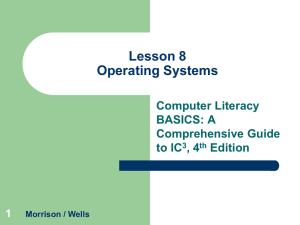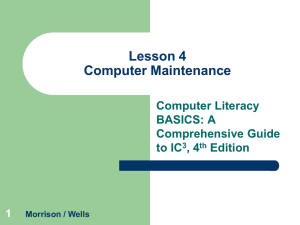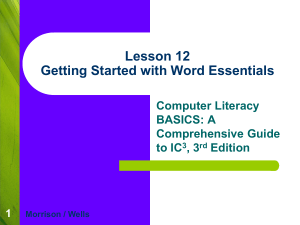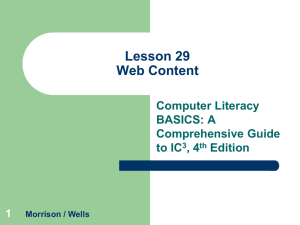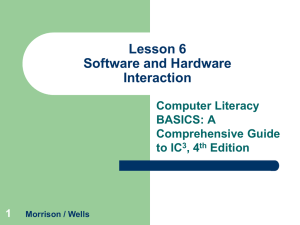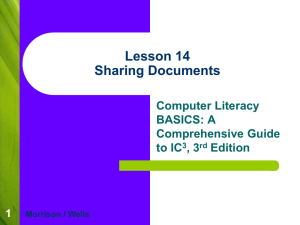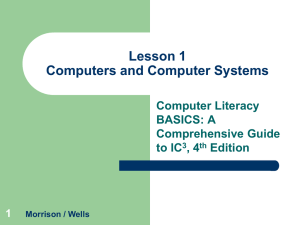File - OHS Graphic Design
advertisement
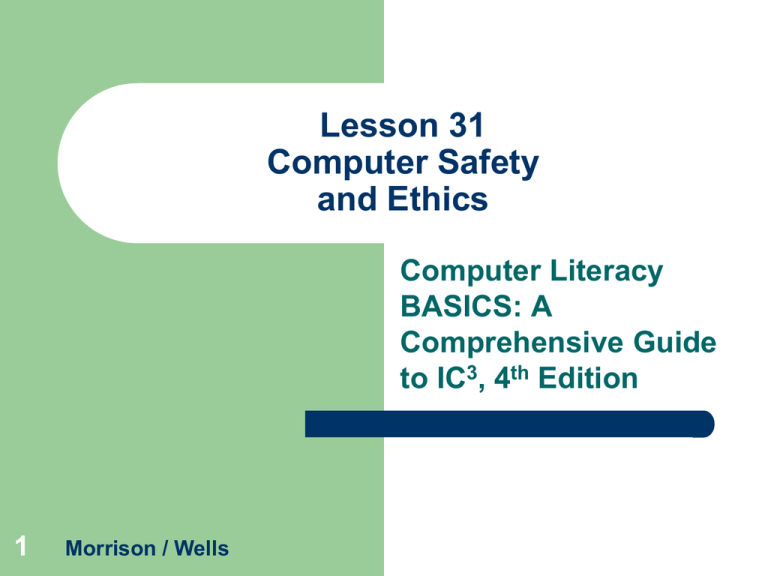
Lesson 31 Computer Safety and Ethics Computer Literacy BASICS: A Comprehensive Guide to IC3, 4th Edition 1 Morrison / Wells Objectives Lesson 31 2 Maintain a safe computing environment. Prevent computer-related injuries. Identify security risks. Set access restrictions. Understand workplace privacy. Avoid e-commerce problems. Morrison / Wells CLB: A Comp Guide to IC3 4E Objectives (continued) Lesson 31 Protect privacy on the Internet. Use the Internet safely and legally. Practice responsibility as a computer user. 3 Morrison / Wells CLB: A Comp Guide to IC3 4E VOCABULARY ASSIGNMENT Lesson 31 4 DIRECTIONS: Create a RAISE YOUR HAND Word document entitled WHEN DONE. I WILL CLB M1L31 Vocabulary. GRADE ONSCREEN. Define the following words (as they relate to computers). Morrison / Wells CLB: A Comp Guide to IC3 4E Vocabulary Lesson 31 5 browser hijacking brute force attacks encryption hacking hardware firewall keylogger phishing private key public key Morrison / Wells repetitive strain injury (RSI) sniffer spyware strong password Transport Layer Security (TLS) CLB: A Comp Guide to IC3 4E Maintaining a Safe Computing Environment Lesson 31 6 Make sure you use a computer in a way that supports your comfort, health, and safety. Pay attention to your posture, lighting, and activity level. Review product safety guidelines provided with your computer or any other electronic device. See www.osha.gov for guidelines. Morrison / Wells CLB: A Comp Guide to IC3 4E Preventing Computer-Related Injuries Lesson 31 7 Take precautions to avoid chronic physical maladies such as eyestrain, back problems, and repetitive strain injury (RSI), which can result when a person makes too many of the same motions over a long period of time. Morrison / Wells CLB: A Comp Guide to IC3 4E Identifying Security Risks Lesson 31 8 An intruder could use a sniffer, which is a program that hackers use to capture user names and passwords on a network. Using Network Protection: When setting up a wireless network, change the default password and turn on some form of encryption. Morrison / Wells CLB: A Comp Guide to IC3 4E Identifying Security Risks (continued) Lesson 31 9 Computer Hacking: Computer hacking involves invading someone else’s computer, usually for personal gain or the satisfaction of defeating a security system. If the network is large, a hardware firewall that controls the computers from one point should be implemented. Morrison / Wells CLB: A Comp Guide to IC3 4E Identifying Security Risks (continued) Lesson 31 10 Avoiding Data Loss: Save frequently. Use surge protectors. Back up important files regularly. Morrison / Wells CLB: A Comp Guide to IC3 4E Identifying Security Risks (continued) Lesson 31 11 Safeguarding Data Against Software Threats: Use strong passwords, install latest security updates, use an upto-date antivirus program. Morrison / Wells CLB: A Comp Guide to IC3 4E Identifying Security Risks (continued) Lesson 31 12 Safeguarding Data Against Software Threats (continued): A strong password is both complex and secure. Strong passwords are more resistant to brute force attacks, which use a script or program to log on to an account using hundreds of words or phrases stored in a dictionary file. A keylogger is a malicious program that records keystrokes. Morrison / Wells CLB: A Comp Guide to IC3 4E Identifying Security Risks (continued) Lesson 31 13 Safeguarding Data Against Software Threats (continued): Hackers often use spyware to control your browser, a practice called browser hijacking. You can also use antispyware software such as Windows Defender to protect your system. Morrison / Wells CLB: A Comp Guide to IC3 4E Video: Computer Security http://www.onguardonline.gov/articles/0009computer-security (3:32 minutes) Lesson 31 14 Morrison / Wells CLB: A Comp Guide to IC3 4E Setting Access Restrictions Lesson 31 15 System administrators and users often restrict access to files, storage devices, computers, networks, the Internet, or specific Internet sites to protect data and other users. Software is available that lets you monitor computer usage, including Web sites, e-mail messages, social networks, instant messaging and chats, and applications. Morrison / Wells CLB: A Comp Guide to IC3 4E Understanding Workplace Privacy Lesson 31 16 Any information gathered from a company’s computer system is company property and not an individual worker’s personal property. The employee normally has no right to personal privacy regarding those issues. Many organizations have computer or network usage policies that provide guidelines for using the organization’s systems ethically, professionally, and legally. Morrison / Wells CLB: A Comp Guide to IC3 4E Avoiding E-Commerce Problems Before providing personal information or credit card information on an e-commerce or similar site, first verify that the site is secure. Lesson 31 17 Morrison / Wells CLB: A Comp Guide to IC3 4E Avoiding E-Commerce Problems (continued) Lesson 31 18 Several companies provide a *Transport Layer Security (TLS) or Secure Sockets Layer (SSL) certificate for e-commerce sites, sites that process sensitive data, and sites that require privacy and security requirements. An SSL certificate consists of a public key and a private key. The public key encrypts information and the private key deciphers the information. Morrison / Wells CLB: A Comp Guide to IC3 4E *OSI Model: TLS and SSL Lesson 31 19 The OSI (Open Systems Interconnection) Model defines a computer networking framework to implement protocols in seven layers. Each layer controls a different function on a network. Morrison / Wells CLB: A Comp Guide to IC3 4E Lesson 31 *OSI Model: TLS and SSL 20 Morrison / Wells CLB: A Comp Guide to IC3 4E Protecting Privacy on the Internet Phishing is a type of computer fraud that attempts to steal your private data. Lesson 31 21 Morrison / Wells CLB: A Comp Guide to IC3 4E Protecting Privacy on the Internet (continued) Lesson 31 22 Cookies and Spyware: Clean up the unnecessary cookies on your computer frequently with a utility program designed for that purpose. Spyware can be harmful as well as annoying. Securing Data: The best way to protect data is to effectively control the access to it. Use strong passwords, use code names or aliases, and always sign off of public computers. Morrison / Wells CLB: A Comp Guide to IC3 4E Reading / Notes Assignment Lesson 31 23 Visit class website: http://ohsgd.weebly.com Reading / Notes: Understanding Mobile Apps – Student downloads > Reading Beware of Spyware Game Morrison / Wells CLB: A Comp Guide to IC3 4E Beware Of Spyware Game Lesson 31 24 http://www.consumer.ftc.gov/media/game-0002-beware-spyware Search: Beware Of Spyware Game. Play the game. Prepare a report (Use Word. MLA format) on what you’ve learned from the Understanding Mobile Apps reading and the Beware of Spyware Game. Include information on how to avoid spyware. Log-in to Jupiter Grades. Click on the CT – Mobile Apps / Spyware Game assignment. The Dropbox will open. Select New Juno Doc. Copy your information from Word into a Juno Doc and click Submit. Morrison / Wells CLB: A Comp Guide to IC3 4E Using the Internet Safely and Legally Lesson 31 25 Nearly all institutions have written policies and guidelines regarding Internet usage. The Department of Justice and other government agencies provide resources for Internet safety. Morrison / Wells CLB: A Comp Guide to IC3 4E Practicing Responsibility as a Computer User Lesson 31 26 It is your responsibility to stay informed about changes and advancements in computer technology, product upgrades, and virus threats. Recycle products such as used computer paper and ink cartridges. Morrison / Wells CLB: A Comp Guide to IC3 4E Lesson 31 Summary 27 In this lesson, you learned: Make sure you use a computer in a way that supports your comfort, health, and safety. When you use a computer, take precautions to avoid chronic physical maladies such as repetitive motion injuries, eyestrain, and back problems that can arise over time. Ergonomic design, which adapts equipment and the workplace to fit the worker, can help to prevent repetitive strain injuries. Morrison / Wells CLB: A Comp Guide to IC3 4E Summary (continued) Lesson 31 28 When setting up your wireless network, your first step should be to change the default password to protect access to the network. Computer hacking involves invading someone else’s computer, usually for personal gain or the satisfaction of defeating a security system. To avoid data loss, you can use techniques and devices for preventing power interruptions. You can also devise and follow a regular procedure for backing up your data. Morrison / Wells CLB: A Comp Guide to IC3 4E Summary (continued) Lesson 31 29 A virus is a program that has been written, usually by a hacker, to corrupt data on a computer. The virus is attached to a file and spreads from one file to another when the program is executed. To protect your computer against virus damage, use up-to-date antivirus software, download and install security updates for your operating system, and avoid opening files sent via e-mail from people you do not know. Morrison / Wells CLB: A Comp Guide to IC3 4E Summary (continued) Lesson 31 30 System administrators and users often restrict access to files, storage devices, various computers, networks, the Internet, or specific Internet sites. If you work for a company that provides you with e-mail services, the information you send is available to the company and is the company’s property. Morrison / Wells CLB: A Comp Guide to IC3 4E Summary (continued) Lesson 31 31 TSL and SSL technology enables encryption of sensitive information by establishing a private communication channel. Data transmitted through this channel is encrypted during transmission. Nearly all schools, government agencies, companies, libraries, and other similar institutions have written policies and guidelines regarding Internet usage. Morrison / Wells CLB: A Comp Guide to IC3 4E Critical Thinking: Group Assignment (Pairs) Lesson 31 Wikipedia contains a Web site dedicated to Internet privacy: http://en.wikipedia.org/wiki/Internet_privacy and review the information contained on the site, then, in a Word document, type and answer the following questions: – – – – – 32 What did you find the most beneficial for you personally? (Answer as a group. There should be more than one thing your group finds beneficial). Detail why your group considers the items you listed beneficial. Discuss the “levels of privacy” as defined in this article. What are evercookies? How can posting photographs online lead to privacy concerns? Log-in to Jupiter Grades. Morrison / Wells CLB: A Comp Guide to IC3 4E Critical Thinking: Group Work (Pairs) Lesson 31 33 Click on the CLB M3L31 CRITICAL THINKING: INTERNET PRIVACY assignment name. The dropbox for the assignment will open. Select New Juno Doc. Select all of the information in your Word document (Ctrl-A) and copy (Ctrl-C) and paste (Ctrl-V) it your report into the Juno Doc. Lastly, submit by clicking “Turn It In Now” in the upper right corner of the Juno Doc dropbox screen. Morrison / Wells CLB: A Comp Guide to IC3 4E
